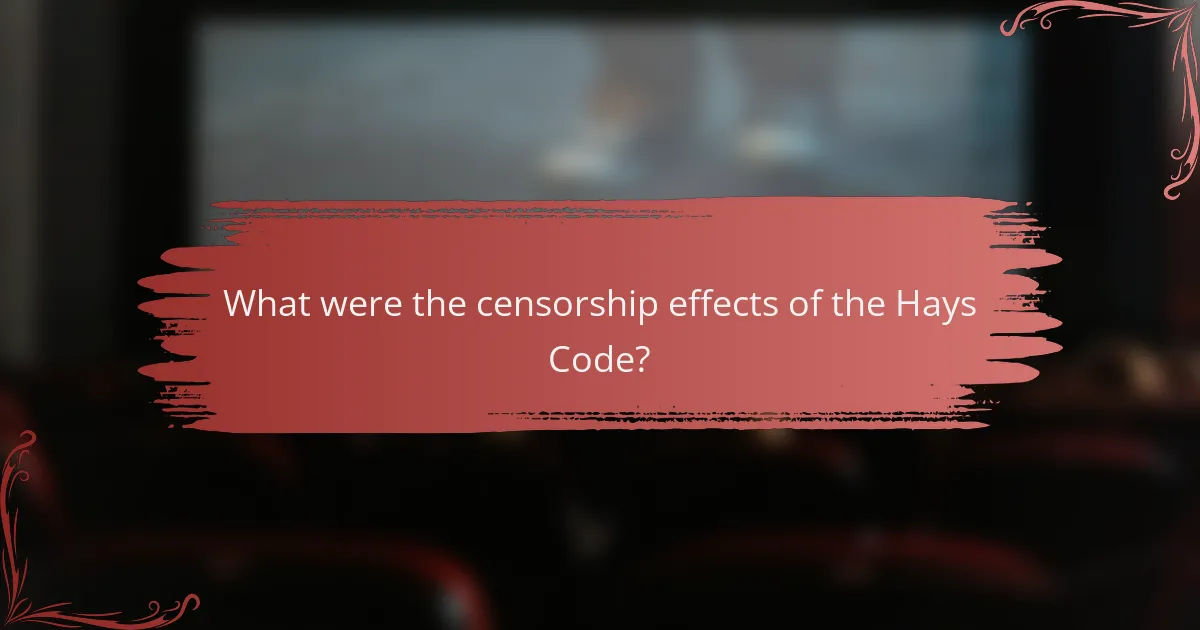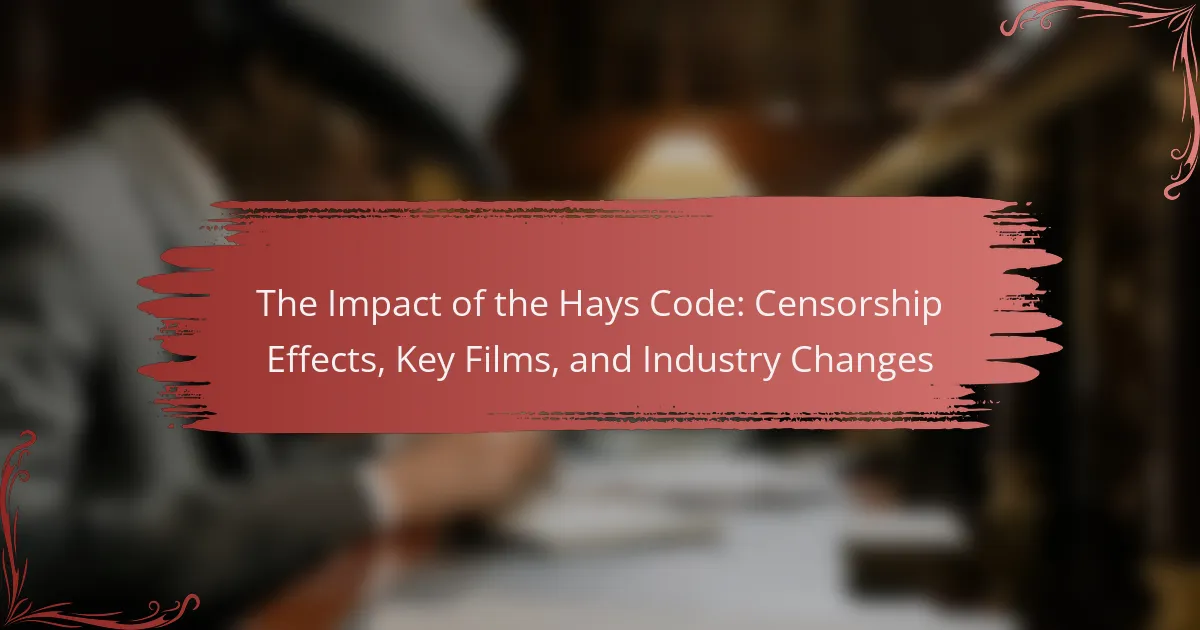The Hays Code, formally known as the Motion Picture Production Code, was a set of self-censorship guidelines established in 1930 for the American film industry. It aimed to enforce moral standards by prohibiting explicit violence, censured content, and themes deemed inappropriate. The Code significantly influenced filmmaking from the 1930s to the 1960s, leading to sanitized narratives and the loss of artistic expression. Key films like “It Happened One Night,” “The Ten Commandments,” and “Gone with the Wind” exemplify the Code’s impact, showcasing how filmmakers navigated its restrictions while shaping societal views on acceptable behavior. Overall, the Hays Code played a crucial role in defining the moral landscape of Hollywood cinema during its enforcement.

What is the Hays Code and its historical context?
The Hays Code, formally known as the Motion Picture Production Code, was a set of industry guidelines for the self-censorship of films in the United States. It was established in 1930 and enforced by the Motion Picture Association of America. The purpose of the Hays Code was to ensure that films adhered to moral standards and did not depict content deemed inappropriate. The Code prohibited explicit depictions of violence, [censured] content, and other themes considered morally objectionable.
Historically, the Hays Code emerged during a time of increasing concern over the influence of films on American society. The 1920s saw a rise in scandalous behavior and themes in cinema, prompting public outcry and calls for regulation. The Catholic [censured] and various civic organizations played significant roles in advocating for stricter content guidelines.
By the mid-1930s, the Hays Code was rigorously enforced, significantly shaping the film industry. Filmmakers had to navigate these restrictions, which led to creative workarounds and the development of a unique style of storytelling. The Code remained in effect until the late 1960s, when changing social attitudes and the rise of new film movements ultimately led to its decline.
How did the Hays Code come into existence?
The Hays Code was established due to the growing concerns about morality in films. In the 1920s, Hollywood faced increasing scrutiny from religious groups and the public. They criticized films for their depictions of violence, sexuality, and immorality. In response, the Motion Picture Producers and Distributors of America (MPPDA) created the code in 1930. Will H. Hays, the MPPDA president, aimed to self-regulate the industry. The code outlined specific guidelines for acceptable content in films. By 1934, enforcement of the code became mandatory. This led to significant changes in film production and storytelling.
What societal factors led to the establishment of the Hays Code?
The Hays Code was established due to societal concerns over morality and decency in film. In the 1920s, rising crime rates and changing social norms led to public outcry. Many believed that films were negatively influencing behavior, especially among youth. The Catholic [censured] and various civic organizations advocated for stricter regulations. They aimed to curb perceived immorality in movies. The lack of a formal film rating system heightened these concerns. In response, the Motion Picture Producers and Distributors of America adopted the Hays Code in 1930. This code outlined guidelines to ensure films adhered to certain moral standards.
Who were the key figures involved in the creation of the Hays Code?
The key figures involved in the creation of the Hays Code were Will H. Hays, Joseph I. Breen, and the Motion Picture Producers and Distributors of America (MPPDA). Will H. Hays was the president of the MPPDA and played a crucial role in establishing the code. Joseph I. Breen served as the head of the Production Code Administration, enforcing the guidelines set by the Hays Code. The MPPDA was instrumental in developing the code to address concerns about morality in films during the early 1930s. The Hays Code was officially adopted in 1930 but was not strictly enforced until 1934, under Breen’s leadership.
What were the main objectives of the Hays Code?
The main objectives of the Hays Code were to regulate the content of films to ensure moral standards. It aimed to prevent the depiction of immorality, violence, and [censured] content. The code sought to promote positive social values and uphold decency in cinema. It established guidelines for acceptable themes and character portrayals. The Hays Code was implemented by the Motion Picture Producers and Distributors of America in 1934. It remained in effect until the late 1960s. The code influenced the types of stories told in Hollywood. It also shaped the portrayal of relationships and societal issues in films.
How did the Hays Code aim to influence film content?
The Hays Code aimed to influence film content by establishing strict guidelines for acceptable material. It sought to promote moral standards in cinema. The Code prohibited depictions of violence, [censured] content, and drug use. It required films to uphold a positive view of life and society. The Hays Code was enforced from 1934 to the late 1960s. It was implemented by the Motion Picture Producers and Distributors of America. The Code shaped narratives to avoid controversial themes. This regulation significantly altered the portrayal of characters and storylines in Hollywood films.
What were the moral standards outlined in the Hays Code?
The Hays Code outlined moral standards for film content. It emphasized that films should promote moral values and avoid immorality. The code prohibited profanity, suggestive nudity, and graphic violence. It mandated that crime should not be portrayed in a way that would inspire imitation. Additionally, it required that all films depict good triumphing over evil. The code also discouraged any depiction of [censured] relations outside of marriage. These standards were enforced from the 1930s until the late 1960s, shaping Hollywood’s narrative style and content.

What were the censorship effects of the Hays Code?
The censorship effects of the Hays Code significantly altered American cinema from the 1930s to the 1960s. The code imposed strict guidelines on film content, restricting depictions of violence, [censured] themes, and moral ambiguity. Filmmakers had to avoid any portrayal of illicit behavior or suggestive dialogue. As a result, many films sanitized their narratives to comply with the code. This led to a loss of artistic expression and the dilution of complex characters. The Hays Code also enforced a moral standard that influenced societal views on acceptable behavior. The impact of the code was evident in notable films that had to be modified or restructured to gain approval. For example, “The Maltese Falcon” underwent significant changes to meet the code’s requirements. Overall, the Hays Code shaped the film industry by prioritizing moral clarity over creative freedom.
How did the Hays Code impact film narratives and themes?
The Hays Code significantly restricted film narratives and themes. It imposed strict guidelines that prohibited explicit content, violence, and immoral behavior. As a result, filmmakers adapted stories to comply with these rules. Many narratives shifted towards moralistic plots and happy endings. Themes of crime and romance were often sanitized or avoided entirely. The Code encouraged the portrayal of traditional family values and social norms. Filmmakers utilized innuendo and subtext to convey [censured] themes subtly. This led to a creative shift in storytelling techniques. Overall, the Hays Code shaped the moral landscape of American cinema for decades.
What common themes were avoided or altered due to the Hays Code?
Common themes avoided or altered due to the Hays Code included sexuality, crime, and drug use. The Hays Code enforced strict guidelines that prohibited the depiction of explicit [censured] content. Films had to avoid showing extramarital affairs or suggestive behavior. Crime was often portrayed in a way that emphasized punishment for wrongdoers. Drug use was either omitted or depicted negatively to discourage substance abuse. These alterations were aimed at promoting moral standards in film. The enforcement of the Hays Code significantly shaped the narratives and character portrayals in Hollywood during its implementation.
How did filmmakers adapt to the restrictions imposed by the Hays Code?
Filmmakers adapted to the restrictions imposed by the Hays Code by altering their storytelling techniques. They focused on suggestive themes rather than explicit content. This included using innuendo and double entendres to convey [censured] themes subtly. They also turned to creative cinematography to imply rather than show. Filmmakers explored complex character development to convey moral dilemmas. They often set films in historical or fantastical contexts to bypass contemporary restrictions. Additionally, filmmakers utilized visual symbolism to express themes indirectly. These adaptations allowed filmmakers to maintain artistic expression within the confines of the Code.
What were the reactions from filmmakers and audiences regarding the Hays Code?
Filmmakers and audiences had mixed reactions to the Hays Code. Many filmmakers felt restricted by its stringent guidelines. They believed it stifled creativity and limited storytelling potential. Some directors and writers openly criticized the Code for its moralistic approach. Audiences, on the other hand, had varied responses. Some appreciated the cleaner content and family-friendly films. Others found the restrictions frustrating and missed the more [censured] themes in earlier cinema. Over time, filmmakers adapted to the Hays Code, often finding creative ways to bypass its limitations. This adaptation led to subtlety and innuendo in film narratives. Overall, the Hays Code significantly influenced the film industry, shaping both production practices and audience expectations.
How did the Hays Code influence public perception of cinema?
The Hays Code significantly influenced public perception of cinema by enforcing strict moral guidelines. This censorship aimed to uphold societal norms and values in films. As a result, filmmakers altered content to comply with the Code. Many films avoided controversial topics or explicit content. This led to a more sanitized portrayal of life on screen. Public audiences began to expect moral lessons and family-friendly narratives. The Code shaped a generation’s understanding of acceptable themes in cinema. It also contributed to the rise of genres like musicals and comedies that fit within its constraints. Overall, the Hays Code molded public expectations and perceptions of film content.
What notable controversies arose from the enforcement of the Hays Code?
The enforcement of the Hays Code led to notable controversies in the film industry. One major controversy involved the censorship of [censured] content and suggestive themes. Filmmakers often clashed with censors over artistic expression. The Code’s strict guidelines resulted in the alteration or removal of key scenes in films. This practice sparked debates about creative freedom versus moral standards. Another controversy arose from the portrayal of race and violence. The Code restricted how these subjects were depicted, leading to accusations of racism and historical inaccuracies. Filmmakers argued that the Code stifled important social commentary. The enforcement of the Hays Code also caused financial disputes among studios and filmmakers. Some believed the restrictions limited box office potential. Overall, the Hays Code’s enforcement ignited significant discussions about censorship and artistic integrity in cinema.

What key films exemplify the impact of the Hays Code?
Key films that exemplify the impact of the Hays Code include “It Happened One Night,” “The Ten Commandments,” and “Gone with the Wind.” “It Happened One Night” showcased strict adherence to romantic comedy guidelines, ensuring no explicit content. “The Ten Commandments” illustrated religious themes while avoiding blasphemy and immorality. “Gone with the Wind” managed to depict controversial themes but within the constraints of the Code. These films reflect how the Hays Code shaped storytelling and content in Hollywood during its enforcement.
Which films were significantly affected by the Hays Code?
Films significantly affected by the Hays Code include “The Maltese Falcon,” “Scarface,” and “The Children’s Hour.” The Hays Code imposed strict guidelines on content, leading to significant alterations in these films. “The Maltese Falcon” was required to tone down its [censured] innuendos and violence. “Scarface” had to remove graphic depictions of crime and violence. “The Children’s Hour” faced censorship regarding its themes of homosexuality. These changes illustrate the profound impact of the Hays Code on film production and storytelling.
What changes were made to specific films to comply with the Hays Code?
The Hays Code mandated significant changes to numerous films to ensure compliance with its moral guidelines. For example, in “The Public Enemy,” a scene depicting violence was altered to reduce its graphic nature. In “Scarface,” the original ending was changed to show the protagonist’s downfall more dramatically, emphasizing moral consequences. “It Happened One Night” was modified to tone down suggestive content in dialogue and scenes. Additionally, “The Maltese Falcon” had to remove certain suggestive elements to align with the code’s standards. These alterations were essential for films to avoid censorship and reach broader audiences during the era.
How did the Hays Code shape the legacy of certain films?
The Hays Code significantly shaped the legacy of certain films by enforcing strict moral guidelines. Implemented in 1934, it aimed to regulate content deemed inappropriate. This led filmmakers to adapt their narratives to comply with censorship rules. As a result, many films from this era focused on themes of morality and virtue. Notable films like “Gone with the Wind” and “Casablanca” navigated these restrictions while achieving critical acclaim. The Hays Code also influenced the portrayal of relationships, limiting depictions of sexuality and violence. Consequently, films often relied on innuendo and subtext to convey deeper meanings. This creative workaround has become a hallmark of classic cinema, enhancing the artistic legacy of many films.
What are some examples of films that challenged the Hays Code?
“Some examples of films that challenged the Hays Code include ‘The Wild One,’ ‘The Moon Is Blue,’ and ‘A Place in the Sun.’ ‘The Wild One’ featured themes of rebellion and violence, leading to scrutiny from censors. ‘The Moon Is Blue’ directly addressed topics like premarital [censured], which was controversial at the time. ‘A Place in the Sun’ explored moral ambiguity and featured a love triangle, pushing the boundaries of acceptable content under the Hays Code.”
How did filmmakers push boundaries despite the Hays Code?
Filmmakers pushed boundaries despite the Hays Code by using subtext and innuendo. They conveyed mature themes without explicit content. Many films employed clever dialogue to suggest ideas indirectly. For example, “The Maltese Falcon” (1941) utilized suggestive language and complex characters. Filmmakers also focused on strong character development to imply deeper issues. They often created layered narratives that hinted at social commentary. Additionally, some filmmakers defied the code through visual symbolism. The use of shadows and lighting helped convey darker themes. Overall, these techniques allowed filmmakers to express controversial ideas while adhering to the restrictions.
What was the critical reception of films that defied the Hays Code?
Films that defied the Hays Code received mixed critical reception. Some critics praised their boldness and artistic integrity. For example, “The Moon is Blue” (1953) was lauded for its dialogue and performances. However, other films faced backlash for their content. “Baby Face” (1933) was initially condemned for its explicit themes. Over time, many films that challenged the code gained recognition as classics. Critics acknowledged their influence on future cinematic storytelling. The reception often reflected societal attitudes towards censorship and morality. Films that pushed boundaries contributed to the eventual decline of the Hays Code.
How did the Hays Code influence the evolution of the film industry?
The Hays Code significantly influenced the evolution of the film industry by enforcing strict content guidelines. Established in 1930, it aimed to regulate morality in films. Filmmakers had to adhere to its rules to avoid censorship. This led to a focus on more wholesome narratives and the avoidance of controversial topics. The Code restricted depictions of violence, sexuality, and drug use. As a result, filmmakers became more creative in conveying messages subtly. The Hays Code remained in effect until the late 1960s, shaping Hollywood’s storytelling approach. Its influence is evident in the transition to the modern rating system.
What changes in production practices resulted from the Hays Code?
The Hays Code mandated significant changes in production practices within the film industry. Filmmakers had to adhere to strict guidelines to avoid censorship. Content deemed immoral or indecent was prohibited. This included restrictions on profanity, [censured] innuendos, and excessive violence. The portrayal of crime had to show punishment for wrongdoers. Films began to emphasize moral lessons and virtuous characters. Production teams implemented thorough script reviews to ensure compliance. The Code influenced the types of stories that could be told in cinema. Overall, the Hays Code reshaped the narrative and visual style of American films.
How did the Hays Code affect the careers of filmmakers and actors?
The Hays Code significantly restricted the creative freedom of filmmakers and actors. It imposed strict guidelines on content, limiting themes related to sexuality, crime, and morality. Filmmakers had to alter scripts to comply with these regulations. This led to a decrease in the variety of stories told in films. Actors often faced typecasting, as they were limited to roles that adhered to the code’s moral standards. Some filmmakers left Hollywood or changed careers due to these constraints. The code was in effect from the early 1930s until the late 1960s, shaping the industry for decades. Many iconic films were altered or censored, impacting their reception and legacy. Overall, the Hays Code stifled artistic expression and influenced career trajectories in Hollywood.
What lessons can be learned from the Hays Code’s impact on cinema?
The Hays Code illustrates the power of censorship in shaping cinematic content. It enforced strict moral guidelines from 1930 to 1966. Filmmakers had to navigate these restrictions creatively. This led to innovative storytelling techniques and subtext in films. The Code also highlighted societal values and norms of the time. It reflected the tension between artistic expression and public morality. The eventual decline of the Hays Code emphasized the industry’s shift toward greater freedom. This change allowed for more diverse narratives and themes in cinema.
How can current filmmakers navigate censorship and creative expression?
Current filmmakers can navigate censorship and creative expression by understanding the legal framework governing content. They should familiarize themselves with local laws and regulations regarding censorship. This knowledge allows filmmakers to create works that comply with legal standards while still conveying their intended messages.
Additionally, filmmakers can use symbolism and metaphor to express controversial themes without direct confrontation. This technique has been historically effective in circumventing censorship, as seen in films during the Hays Code era.
Collaborating with advocacy groups can also provide filmmakers with support and resources to address censorship challenges. Engaging audiences through social media can help raise awareness about censorship issues, fostering public dialogue.
Finally, filmmakers should explore international markets where censorship may be less restrictive. This approach allows for broader creative expression while reaching diverse audiences.
What parallels can be drawn between the Hays Code and modern censorship issues?
The Hays Code and modern censorship issues both aim to regulate content deemed inappropriate. The Hays Code, established in the 1930s, restricted films based on moral standards. Similarly, modern censorship addresses concerns over violence, language, and [censured] content in media. Both frameworks reflect societal values and norms of their respective times. Enforcement mechanisms in both eras involve industry self-regulation and public pressure. The Hays Code was enforced through a rating system, while modern censorship often utilizes content warnings and age restrictions. Both can lead to creative limitations for filmmakers and artists. Each approach generates debates about freedom of expression versus societal responsibility. Historical context shows that censorship evolves with cultural shifts, influencing what is considered acceptable.
The Hays Code, formally known as the Motion Picture Production Code, was a set of industry guidelines established in 1930 to regulate film content in the United States based on moral standards. This article examines the historical context of the Hays Code, its societal influences, and key figures involved in its creation. It also explores the censorship effects on film narratives and themes, notable films impacted by the Code, and how filmmakers adapted to these restrictions. Furthermore, the article discusses the legacy of the Hays Code and its implications for modern censorship issues in cinema.
